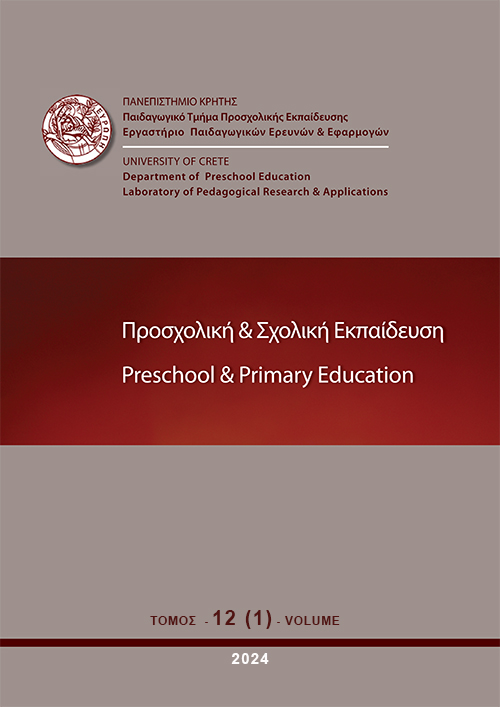Η σημασία της εκμάθησης γραφής του ονόματος για την ανάδυση του γραμματισμού
Περίληψη
Η παρούσα έρευνα, που αποτελεί μέρος μιας ευρύτερης διαχρονικής μελέτης περίπτωσης, έχει ως βασικό στόχο την αποτύπωση της εξελικτικής πορείας της εκμάθησης γραφής του ονόματος από ένα παιδί κατά τη φάση του αναδυόμενου/πρώτου γραμματισμού του και αποσκοπεί να καταδείξει την επιρροή που η διαδικασία αυτή άσκησε στην ανάδυση των ικανοτήτων του στη γραφή. Η έρευνα εστιάζει στην εις βάθος ανάλυση των γραπτών παραγωγών ενός αγοριού υψηλής κοινωνικής προέλευσης, του Ανδρέα, εξετάζοντας την περίοδο από τη γέννησή του έως την είσοδό του στο δημοτικό σχολείο. Από την αποτίμηση των αποτελεσμάτων διαπιστώθηκε η ικανοποιητική σκιαγράφηση της πορείας που ακολούθησε έως την εκμάθηση της γραφής του ονόματός του και αναδείχθηκε ο κεντρικός ρόλος της προσωπικής υπογραφής ως προς την κατάκτηση του κώδικα της γραφής από το παιδί.
Λεπτομέρειες άρθρου
- Πώς να δημιουργήσετε Αναφορές
-
Γαλάνης Γ., & Στελλάκης Ν. (2024). Η σημασία της εκμάθησης γραφής του ονόματος για την ανάδυση του γραμματισμού. Preschool and Primary Education, 12(1), 87–113. https://doi.org/10.12681/ppej.34794
- Ενότητα
- Άρθρα

Αυτή η εργασία είναι αδειοδοτημένη υπό το CC Αναφορά Δημιουργού – Μη Εμπορική Χρήση – Παρόμοια Διανομή 4.0.
Οι συγγραφείς των άρθρων που δημοσιεύονται στο ΠΡΟΣΧΟΛΙΚΗ & ΣΧΟΛΙΚΗ ΕΚΠΑΙΔΕΥΣΗ διατηρούν τα δικαιώματα πνευματικής ιδιοκτησίας επί των άρθρων τους, δίνοντας στο περιοδικό το δικαίωμα της πρώτης δημοσίευσης. Άρθρα που δημοσιεύονται στο ΠΡΟΣΧΟΛΙΚΗ & ΣΧΟΛΙΚΗ ΕΚΠΑΙΔΕΥΣΗ διατίθενται με άδεια Creative Commons 3.0 και σύμφωνα με την άδεια μπορούν να χρησιμοποιούνται ελεύθερα, με αναφορά στο/στη συγγραφέα και στην πρώτη δημοσίευση για μη κερδοσκοπικούς σκοπούς και με δικαίωμα τροποποίησης μόνον με παρόμοια διανομή (αν αναμείξετε, τροποποιήσετε, ή δημιουργήσετε πάνω στο υλικό, πρέπει να διανείμετε τις δικές σας συνεισφορές υπό την ίδια άδεια όπως και το πρωτότυπο). To Εργαστήριο Παιδαγωγικών Ερευνών και Εφαρμογών του Παιδαγωγικού Τμήματος Προσχολικής Εκπαίδευσης του Πανεπιστημίου Κρήτης και το Εθνικό Κέντρο Τεκμηρίωσης διατηρούν το δικαίωμα να δημοσιεύουν, να αναπαραγάγουν, να παρουσιάζουν στο κοινό, να διανέμουν και χρησιμοποιούν άρθρα που δημοσιεύονται στο ΠΡΟΣΧΟΛΙΚΗ & ΣΧΟΛΙΚΗ ΕΚΠΑΙΔΕΥΣΗ σε οποιοδήποτε μέσο και μορφή είτε μεμονωμένα είτε ως μέρη συλλογικών έργων, για όλο το χρόνο διάρκειας προστασίας της πνευματικής ιδιοκτησίας και για όλες τις χώρες του κόσμου. Αυτό περιλαμβάνει ενδεικτικά και όχι αποκλειστικά, το δικαίωμα δημοσίευσης των άρθρων σε τεύχη του περιοδικού ΠΡΟΣΧΟΛΙΚΗ & ΣΧΟΛΙΚΗ ΕΚΠΑΙΔΕΥΣΗ, αναπαραγωγής και διανομής μεμονωμένων αντιγράφων των άρθρων, αναπαραγωγής ολόκληρων των άρθρων σε άλλη έκδοση του Εργαστηρίου Παιδαγωγικών Ερευνών και Εφαρμογών του Παιδαγωγικού Τμήματος Προσχολικής Εκπαίδευσης του Πανεπιστημίου Κρήτης και του Εθνικού Κέντρου Τεκμηρίωσης και αναπαραγωγής και διανομής των άρθρων ή περίληψης αυτών με χρήση πληροφορικού συστήματος αποθετηρίου.



